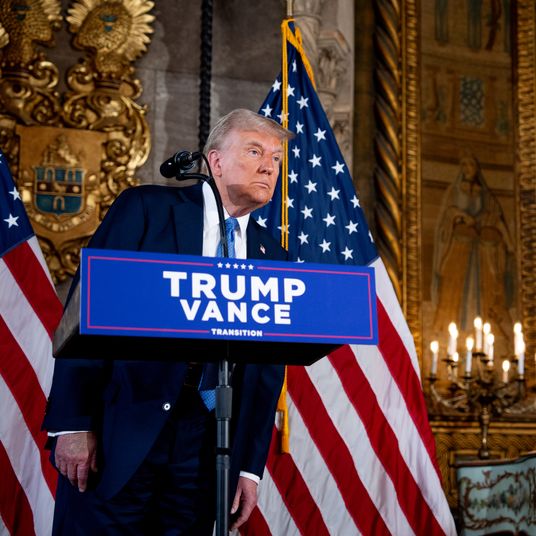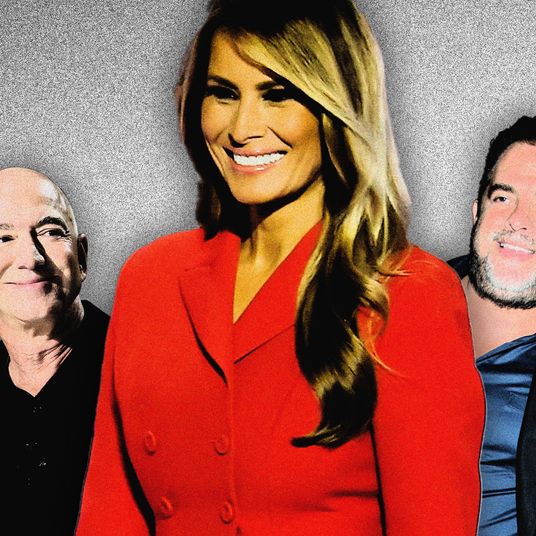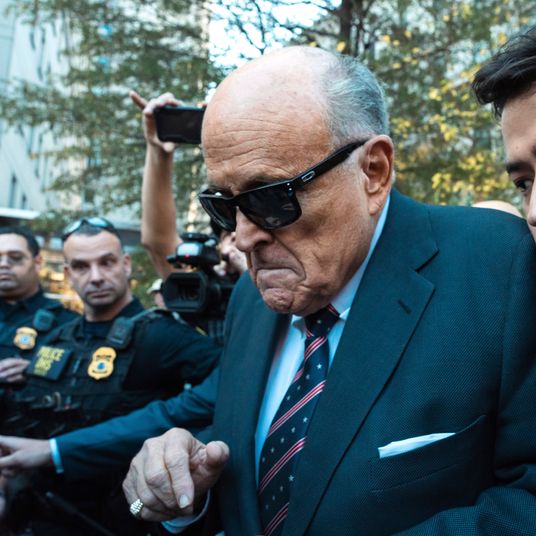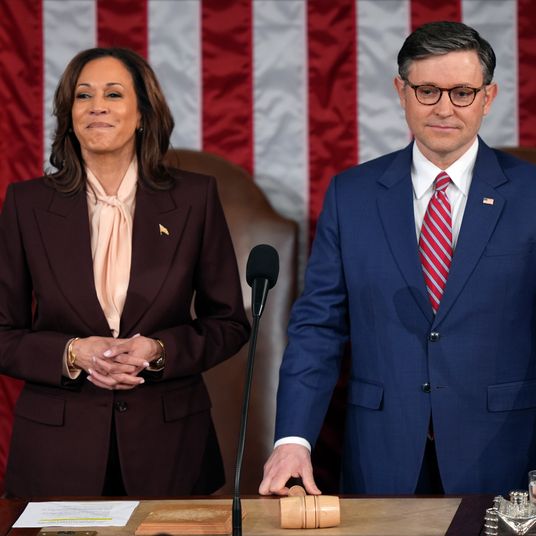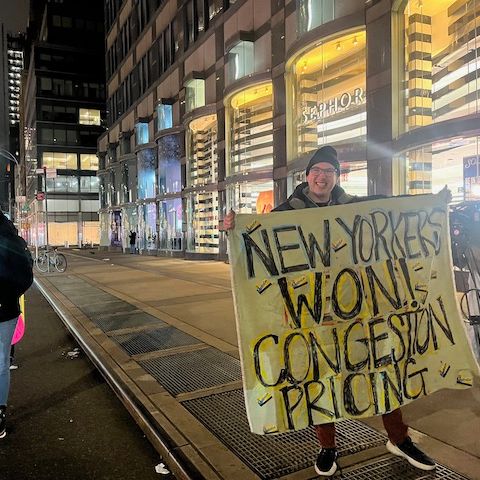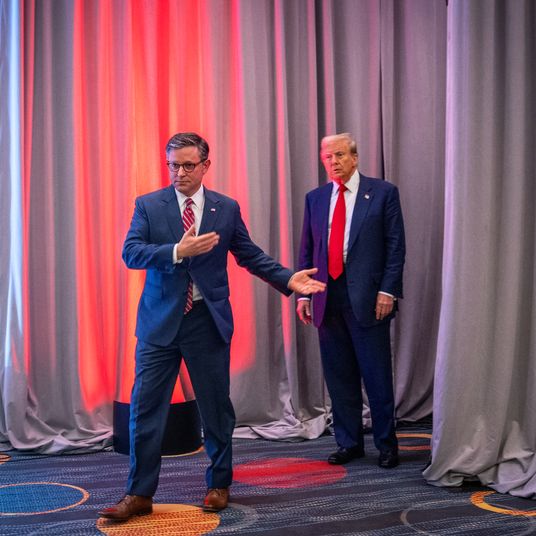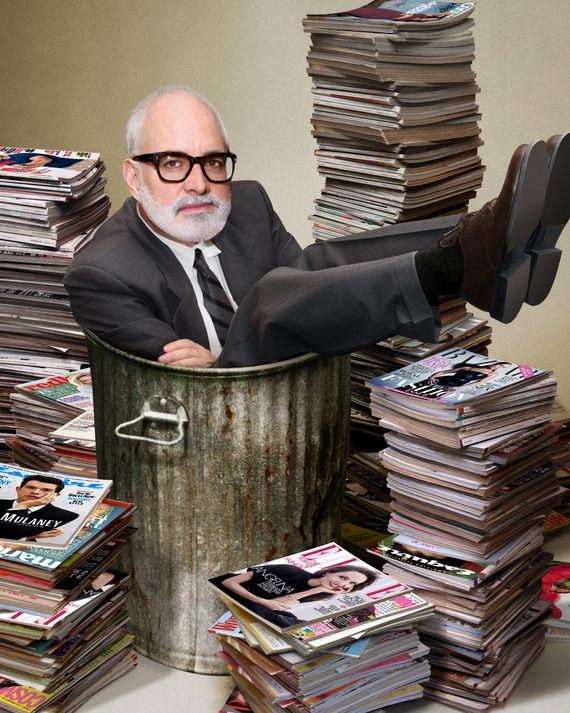
This article was featured in One Great Story, New York’s reading recommendation newsletter. Sign up here to get it nightly.
On the evening of July 22, a New York Times story began pinging around among employees of Hearst Magazines, one of the few surviving titans of the magazine era. It was titled “Hearst Employees Say Magazine Boss Led Toxic Culture.” The Times piece had been brewing for a while and was widely anticipated within the company, but its revelations had been expected for much longer. There was “a mass influx of text messages,” a former digital manager recalls of the moment the Times story dropped. “‘Finally, this day was bound to happen’ … ‘At last’ … ‘Long overdue.’” But the specific remarks that Troy Young, then Hearst’s president, was reported to have made, even as rendered in family-friendly Times-ese, were shocking: At a holiday party, he’d suggested a Cosmo editor should have “inserted her fingers into herself” (in real life, he said, “into your pussy”) and presented them to her date to smell; in a Cosmopolitan conference room full of sex toys, he’d said he would need one with a wider “opening” (in real life, he said, “‘I need a soup can,’” a female executive who was present recalls. “It sort of ruined Campbell’s for me”).
If anyone was surprised, it seems, it was Hearst CEO Steve Swartz, who clearly hadn’t calculated how events would unfold over the next few days. Swartz had felt, according to a Hearst executive, that Young’s remarks, while indefensible, were not a firing offense: Many of Young’s cruder comments reported in the Times piece had occurred in and around a magazine at which frank talk about sex toys and blow jobs is part of the job description. (“Troy didn’t have sufficient maturity,” the Hearst executive says, “but Cosmo is not a normal place.”) The remarks had occurred years before. There had been no “hotline” complaints to Hearst’s legal department and, according to this executive, no settlements involving Young — an area the Times had inquired about. And Young had been receiving coaching to become a more polished executive.
“Since we knew the piece was coming,” the Hearst executive says, “the strategy was always that Troy would have a chance to address it.” Young told the Times he regretted “the toll” that “the pace of evolving our business and the strength of my commitment” had “taken on some in our organization,” and a Hearst spokesperson allowed that Young’s “brash demeanor” had “rubbed some the wrong way.” Young had prepared an email that was supposed to go out to employees on July 22, though it ended up not going out until the following afternoon. In it, he disputed the gist of the Times report while saying he was “deeply reflective on what I can learn from this moment.”
“People didn’t love the way he was allowed to respond within that story,” a former Cosmopolitan.com editor says. “It felt like Hearst was fully behind him with that non-denial denial that was in the story.” But deeply upset employees were already flooding their managers with complaints. Some of the more senior employees who knew Young, according to the Hearst executive, “kind of rolled their eyes at [Young’s reported behavior], but younger women on the teams — they had serious issues.” It wasn’t just younger women, however. “We all went crazy,” says an older executive, “and fired off emails to the senior leadership saying it was outrageous and he had to go.”
Just five hours after Young’s email went out, Swartz released a terse statement that he and Young had agreed “it is in the best interest of all of us for him to resign his position.”
On July 24, the company named Debi Chirichella, the magazine division’s CFO, to replace Young on an acting basis. Chirichella sent a note to employees acknowledging the need “to rebuild trust within our organization” while stating that “no one in leadership, including myself or anyone at the corporate level, knew about these grotesque allegations.” Chirichella was well respected and seen as someone who could be an able steward of the operation, if not a creative visionary, but people who’d experienced Young’s offenses were skeptical of her disclaimer (the Hearst executive says Chirichella was referring to the specific stories recounted in the Times article) and frustrated with Swartz’s reticence. “There’s such disappointment with Steve,” a female former Hearst executive says. “He left them all to burn and then made a woman send the note.”
Whatever Young’s personal and interpersonal shortcomings, he had enjoyed the protection of Hearst’s leaders for the past seven years for a simple reason: He was taking Hearst to what seemed to be its inevitable future, one where the company’s growth was reliant on cheap, viral content, not lavish, expensive-to-produce print stories or digital features. But his departure came at yet another moment of reckoning for the already diminished magazine industry, which, after being hammered for years by declining print ad sales, saw the bottom fall out on digital advertising during the first few months of the pandemic. A few prestige brands (including The New Yorker and The Atlantic) have weathered declining ad sales by creating subscription products — but that model depends on making content that readers want to pay for. Hearst now finds itself in a vulnerable moment. Having traded its valuable but cash-draining legacy brands for a nimble and future-focused vision, the man with the vision has left the building, and even those who aren’t romantic about print wonder whether the transition can really be effected by bureaucrats.
Despite occupying an impressive, origami-inspired midtown office tower and sharing a name with one of America’s great dynastic fortunes, Hearst Magazines has always existed in the shadow of rival glossy publisher Condé Nast. Elle could never be Vogue. Hearst wasn’t synonymous with lavishly salaried and perked one-name celebrity editors à la Graydon and Anna. While Si Newhouse, Condé’s longtime owner until his death in 2017, loved magazines and was willing to take losses on them, Hearst was the cheap, quietly money-minting company that, with the exception of a handful of titles such as Esquire, made things for people in flyover country and didn’t aspire to chattering-class prestige. “The family cares about nothing except money,” says the author Michael Wolff. “For four generations, if the family got its dividend, it was happy. The entire company was structured to protect that dividend.”
Condé was the drama machine where editors learned they’d been fired on the evening news and ex-assistants wrote fictionalized tell-alls like The Devil Wears Prada. “You never heard Si talk about the character of the company,” says an editor who has worked at both Condé Nast and Hearst. “You heard him talk about aesthetic or literary achievements.”
Hearst wasn’t as thoroughly genteel as it liked to present itself. “The thing is that everybody there saw everyone else’s numbers,” a former editor-in-chief recalls, “which was kind of Game of Thrones–ian.” But its culture reflected the stolid, unflashy, middle-American values of Frank Bennack, a Texan beloved by the Hearst family, who, as CEO from 1979 to 2002 and again from 2008 to 2013, was revered as a proverbial handshake guy who largely built the modern company. It was a place that respected its elders. Bennack, in his 80s, still sits on the board and is one of a handful of wise men—they are nearly all men — still influential within the company. They have offices on the 42nd and 43rd floors and speak of their female “secretaries,” who address their bosses as “Mister.”
When David Carey arrived as magazine-division president in 2010 from Condé, after a very successful run as publisher of The New Yorker (and a less fortunate stint as publisher of Portfolio, a poorly timed new business magazine on which Condé lost nearly $100 million before folding), Hearst was both behind and ahead of its peers in finding its footing online. Though a handful of Hearst editors had created vibrant digital extensions of their magazines, the company as a whole was a laggard, its websites publishing at a glacial print cadence with nothing new on evenings and weekends and no sense of urgency or the need to frequently refresh content. At the same time, Hearst Ventures, the company’s investment arm, had shrewdly bought a stake in hugely successful digital native BuzzFeed, giving Hearst precious insight into how to make money on the internet (the company later took stakes in Refinery29 and Vice). In the late aughts, Carey had seen print and digital fiefdoms battle to little effect at Condé — where, for instance, content from Gourmet and Bon Appétit was funneled onto the web through the completely separate brand Epicurious — and became convinced that “digital pure plays,” unburdened by the rules and people of the legacy magazine business, would always prevail in building audiences.
In 2013, Carey hired Troy Young, who had been consulting for Hearst for the previous eight months — focusing on how to make Cosmopolitan.com profitable, since newsstand sales of the print magazine, the division’s biggest moneymaker by far, were plunging like nearly every magazine’s at the time — to run the digital division. Young had grown up in Regina, a small city in the central Canadian province of Saskatchewan; his father, he would later recall in an interview, had “invested a lot in getting me out of this kind of toxic environment,” sending him over 1,000 miles west to a boarding school on an island near Vancouver. After studying finance and economics at Queen’s University in Ontario, he bounced around jobs before finding a focus in digital media. By the time he was 28, he had moved to Toronto, had the first of his three children, and was embarking on a career in interactive advertising. Eventually, this led him to San Francisco, where he became president of Say Media, a company that provided a blogging platform for such brands as Remodelista, xoJane, and ReadWrite.
“He was basically an ad guy in the mix, trying to be part of the future,” says an industry observer based in Silicon Valley. In a sea of antisocial coders, Young was more of a salesman. “He was noticeably slicker and more used to business presentations and communicating in that style,” says the observer, who recalls Young “making a joke about wife swapping in Marin County. He said it in a casual way, like he was involved with it, but not in a way that was too explicit. I thought it was funny, but it was a risk to make that joke to me. That stuck in my mind to this day.”
During this period, Young began consulting for L.A.-based SpinMedia (then-owner of the websites Spin, Stereogum, and The Frisky, among others) and Hearst, dividing his time between coasts. “I learned a lot from Troy,” says Steve Hansen, who was running SpinMedia at the time. “I don’t want to call him a bull in a china shop, but he thinks with great clarity. He’ll use interpersonal skills to the extent he needs to, but he’s just not wired that way. When he got the position at Hearst, I said, ‘Does that mean you have to wear cuff links every day?’ He’s definitely not that guy.”
When Young went to Hearst full time, the industry observer recalls, “I thought, That makes sense. He was a media guy. From a tech perspective, his career path looked like he couldn’t make it in the big leagues, and he bounced out to a smaller place he could hang in. Hearst, for all its history, is not a place you go if you’re ambitious in the tech industry. Everything Troy was talking about was extremely basic. You’re taking best practices from other industries” — aggregating disparate properties on a single platform to draw traffic and advertising — “and applying them to a place that used to operate on martini lunches. It’s really kind of amazing that he parlayed this fairly mediocre career, as far as people in tech are concerned, to this thing that’s really big to people in the media world.”
Hearst editors were at first excited when Young arrived, one says, thinking he would help them digitize their brands. But he quickly alienated many editors. “He was arrogant,” one recalls. “He had no interest in learning about the media.” Young spoke in a grating Silicon Valley argot about “the sprint toward excellence” and how he was going to “pressure-cook” an idea. He would arrive late to meetings, slightly disheveled, talk about getting stoned over the weekend or going to Burning Man, slouch on the sofa with a toothpick in his mouth, and lace his conversations with discomfiting sexual observations.
More consequentially, Carey had given Young a free hand to evolve Hearst’s digital business. One of his first moves was to wrest control of the websites from the magazine editors and install his own people to run them. It was inevitable that this would cause umbrage. Young also seemed to go out of his way to antagonize.
Young’s un-Hearstian bravado seemed to instill confidence in Hearst executives while it struck others as a posture, an analog person’s idea of a digital person. “When we’d complain about it, they’d say, ‘You can’t handle a disruptor,’” a former Hearst editor says. “That’s what made everyone so angry. Everyone was more digital than David and Steve. They were weirdly antediluvian in not understanding that.” Why, the editors wondered, was a leading media company putting its future in the hands of someone who had run a middling start-up in Silicon Valley? “It was like watching a dystopian Music Man. He spun them this digital bill of goods.” Young locked horns in particular with Esquire’s longtime editor, David Granger, who, in response to Young’s annexation of Esquire.com, set up a new paywalled website, Esquire Classic, which would host the magazine’s archives and offer digital versions of each new issue and over which Young had no control.
By all accounts, Young did what he had been hired to do. He slashed costs by simplifying Hearst’s digital businesses, bringing the brands’ far-flung websites onto a single platform and unifying their design. And he pursued traffic. With the help of a deputy named Kate Lewis, who had also come from Say Media, Young proved adept at optimizing clickbait, pushing digital editors to run posts that would rank high on Google because they included popular search terms. Young wasn’t doing anything particularly radical — “His strategies were very BuzzFeed-y,” an ex-editor says — but he was doing it within a vaunted magazine company. Lewis created a “digital newsroom” that could produce content for all the websites from a centralized desk; Young oversaw the building of a new content-management system, irreverently called Patty (as in Patty Hearst), which further facilitated the content sharing, and Hearst Digital built a machine-learning algorithm that predicted a new post’s trajectory. “If in the first hours after it went up, our predictive-learning algorithm said this is on track to be hit content,” someone involved in the algorithm’s development recalls, “we’d have it show up across brands. So in Elle Decor, if an article about a Kim Kardashian couch is taking off, maybe we should throw it in Cosmo. And it worked. With a great piece of content, it doesn’t matter where it came from.” The cross-linking dramatically boosted traffic across Hearst’s network. “We got a 20 percent lift in audience at no cost,” a Hearst executive says.
Part of what Young had been brought in to do was experiment. During his tenure, Hearst’s recipe website, Delish, became one of the five most popular food sites on the internet by making heavy use of video. Young also launched BestProducts.com, a Wirecutter-like product-recommendation site. “E-commerce is a hugely important part of current revenue streams,” a Hearst executive says, “and it was born because Troy and the digital leadership could execute without noise from the print products.” E-commerce, the executive continues, has driven Good Housekeeping to “strong profit growth” this year.
But there were a lot of people still at Hearst for whom an article about Kim Kardashian’s couch could never be a great piece of content, much less one worth sharing across the company’s sites. Editors felt Young and Lewis were blurring the brands’ distinct identities and dragging all of them down with lowest-common-denominator dreck. “It was like if you put the worst possible gas in the nicest possible car,” an Esquire digital editor recalls. “It will still run.” Some of Young’s digital advances seemed counter to the direction in which the print magazines were being pushed. Joanna Coles, then the editor of Cosmo, had been tasked with making it smarter and more upmarket; in her second issue, she’d published a 20-page excerpt of Sheryl Sandberg’s Lean in, and she’d also appointed Sandberg to be the magazine’s careers editor. After Cosmopolitan.com published an article titled “I Had Sex With Myself on the Q Train While Eating a Gyro,” Coles met with Young and Carey to complain. Editors at Harper’s Bazaar saw Bachelor recaps and political news start to show up on their fashion-focused site. In two instances when Cosmo stories about lube and butt plugs appeared on Esquire.com, former Hearst editors recall, luxury-fashion advertisers complained. It wasn’t that Esquire never covered sex, but this, a former editor says, “was not Nora Ephron writing about her small breasts.” Cross-linking could make sense when, say, Popular Mechanics reviewed barbecue grills and Esquire republished the piece; it made less sense to see an Esquire paean to Italian loafers show up on the Popular Mechanics site.
It wasn’t just print editors fretting; journalists on the digital side, too, worried about the direction Hearst seemed to be taking. What was Kanye West doing on Town & Country’s site? Lewis would issue what seemed like capricious directives, announcing, for instance, that she didn’t like reading Q&A’s and demanding that editors who wanted to run them strip the Q’s out of them and only publish the A’s. “Everything was premised on the idea that people don’t read,” a former Esquire digital staffer says. “We were encouraged to have short paragraphs, broken by links and Spotify embeds and YouTube embeds and images, so that, scrolling on a phone, you wouldn’t just see white space.”
Journalists on the digital side “were all wondering why we were reporting to this woman who had come from HR,” a female site editor recalls, referring to Lewis’s prior stint in Condé’s personnel department. Lewis had the unpopular task of cutting budgets, and a site editor recalls sitting with her as Lewis presented a spreadsheet of the site’s writers, their traffic, and their pay rates and told her to cut any writers whose traffic didn’t justify their pay. “All they cared about was traffic.” (Lewis didn’t respond to an interview request.)
“Of course, we all wanted it to be smart,” the Esquire digital staffer says. “I felt like I was working at a content farm and managing listicles and what’s on Netflix this week. I wanted to be working on more serious stuff, but I wasn’t able to with my bandwidth and we never had any money.” An Elle editor recalls sitting through a meeting of editors and executives and thinking that, as Young spoke, “it felt like the end of journalism to me. If journalism ever had a real hold at Hearst, it was deader than dead.”
On the print side, revered longtime editors, including Esquire’s Granger and Elle’s Robbie Myers, were pushed out, and tensions with remaining editors ratcheted higher. After Town & Country editor Jay Fielden replaced Granger at Esquire in early 2016, Young began showing up on the 21st floor, where Fielden would return to his office to find him sitting in his chair, going through his things. “Just an ’80s-CEO power move,” another Hearst editor from that time says. “Art of War shit. Michael Scott shit.” In another instance, Young, who was proud of his recently launched CMS, Patty, asked Fielden if he’d seen it. Fielden happened not to have yet, and when he said so, Young replied, “Maybe you should have your assistant print out the page for you, and you can look at it.” Fielden privately referred to Young as Digital Jesus.
Coles, who was promoted from editor of Cosmo to chief content officer in fall 2016, told a colleague she found Young so disturbing that whenever she received a group email from him concerning a matter she considered beyond his borders, she would remove his name from the addressees before hitting “reply all.” After Coles joined the board of Snap, Inc., and it was reported (inaccurately) that she was being paid less than the other (all-male) board members, a digital executive recalls, “I remember Troy had a good chuckle over it. It was pretty petty.” Coles, while declining to be drawn into a rehashing of events, told me, “I made no secret of the fact that I really didn’t like working with him, and I know he made a lot of people feel uncomfortable a lot of the time.”
A Hearst executive suggests that some print editors were unhappy because their jobs were becoming less glamorous. While Young was building out a new office for his division in the Sheffield building, next to Hearst Tower, he was cutting costs by having a single team cover major cultural events like the Oscars and the Met Ball, which different magazines used to cover separately. “Print editors hated that,” the executive recalls. “Why? Because one of the editors in New York who was so against it used to take one of her children to the Grammys in L.A. every year, and part of this was that we weren’t going to do that anymore.”
Some editors believed Swartz and Carey had been bedazzled by Young. They observed that Carey started dressing more casually and, like Young, wearing a beard. “People felt David had a boy crush on Troy.” (Carey told people his new style was actually inspired by socially conscious Salesforce CEO Marc Benioff.) For Swartz, who had never possessed the larger-than-life quality of Bennack — whom many still viewed as the effective CEO — “there could be a Freudian understanding of why a swaggering, big-talking disruptor-in-chief character made Steve light up.”
Or maybe they just liked Young’s numbers: Between 2012 and 2017, Hearst Magazines’ annual digital profits, including international, rose from zero to $72 million. By 2018, Hearst would become the ninth-largest digital company in the country in unique visitors, according to Comscore, ahead of both Apple and Disney. While Condé closed or sold half its magazines, and Time Inc. disappeared altogether, most of Hearst’s print magazines survived, albeit with lower frequency in some cases. “Our staff reductions would have been enormous without the digital profits,” a Hearst executive says. (Those profits did not, however, save the 145 people laid off when Hearst acquired the magazine division of Rodale in 2018.)
Young had built a business but not a journalistic enterprise, and his reign can be seen as reflecting the ways that the onlining of media has often rendered those goals incompatible. Where in the traditional print model, good journalism was rewarded with more readers and thus more advertisers, in Young’s digital model, which was all about scale, journalism of the sort that requires long-term investment is only in rare instances predictably remunerative.
“Troy was usually always right on the substance of arguments, but he was often wrong on style,” a Hearst executive says. “And print editors were often wrong on the substance but in terms of style much better.”
“The digital strategy was solid,” another Hearst executive echoes. “[The problems were] more about the personality than the plan.”
The Times revelations about Young focused on comments he made to Cosmo staff and writers, including asking a pregnant editor, “Is the baby mine?” But Young was, by many accounts, an equal-opportunity offender. Over drinks with Esquire digital staff at Lincoln Park, a bar on Ninth Avenue, Young hazed a digital editor about how much pubic hair he had and grilled a young politics writer who was living with his parents about whether he masturbated and watched porn at home, not relenting until finally the writer said, “I don’t know, does your son masturbate at home?” At another Hearst event, Young went up to two male publishers and said, “Which one of you fucks the other up the ass?” He would call employees “faggot” and an Italian American woman on the digital side a “wop.” A former Esquire editor says, “I’ve been in meetings where he’d say stuff like ‘It smells like my dead grandmother in here after I fucked her’ as an icebreaker.” He told a digital executive who’d just returned from maternity leave that she was a “MILF” and a “sexy mommy.” During a meeting of senior executives, two women seated behind him were stunned to see that he was watching porn on his phone.
Some viewed Young as a coarser, meaner Michael Scott, someone who had mistaken The Office for a MasterClass on leadership. “He sort of thinks he’s a swashbuckling badass,” recalls a female digital editor, “but he’s really just kind of an awkward guy.” Another editor who clashed with Young suggests he was deliberate in his provocations: “It worked for him. It wasn’t just a bad habit. It was part of how he got what he wanted. He knew it made people leave him alone. I think because he did so much of it right in people’s faces, almost like an exhibitionist, he thought that would get him through it.” It’s entirely possible, if disturbing to consider, that Hearst understood it couldn’t make the changes it wanted without hiring an overtly antagonistic person to do it and that Young’s personality was the feature rather than a bug.
Coles complained repeatedly to Carey about Young. On one occasion, Young showed Fielden a video on his phone that began innocently enough, with a woman in a kitchen making a recipe; several seconds in, as Fielden later told a colleague, the video jarringly cut to porn in which a man was slapping a woman’s face with his penis. After Fielden experienced further troubling incidents and witnessed others involving female colleagues, he decided he needed to report what he knew to Carey. (A Hearst spokesperson says Carey “does not recall these conversations, but he does remember conversations about how pornography was covered on Esquire.com.”) Another female executive complained to HR about Young in 2017 regarding, among other things, the fact that “he threw around the word faggot.” (Over email, Young said, “I have always been one to engage colleagues with an openness and candor that was unusual at my level and, in hindsight, may have created an informality that was not appropriate. This was never done out of malice.”)
“I began to go, Who is this guy?,” a former editor recalls. “How do I go to another Hearst cocktail party where Bennack or Carey talks about Hearst’s integrity? It all began to feel like being gaslit.” A former Hearst executive recalls Lincoln Millstein, an adviser to Swartz, saying in 2016 about Young, “He’s toxic, we know the problems, and we’re getting rid of him.”
In 2018, after Carey announced he would be leaving Hearst, the company said it would begin a search process for his successor and consider both internal and external candidates. Four weeks passed. Within Hearst and outside it, this delay was perceived to be due to an ongoing “bake-off” between Young, leader of the underpaid digital army, and Coles, champion of the print-mag dinosaurs. It seemed as if the soul of Hearst hung in the balance. “Either the legacy side of the magazines was going to win out,” a former Esquire digital editor says, “or Troy was going to win out.”
One reason people wanted Coles to get the job was symbolic: Although many of its most important magazines targeted women and preached female empowerment, Hearst’s leadership was overwhelmingly male. But Coles was never a serious contender. While she had expressed initial interest in the job, she never formally applied, recognizing that it was a revenue job that would almost certainly be filled by a businessperson.
The real bake-off was between Troy Young the moneymaking executive and Troy Young the HR headache. He was the obvious candidate, but he’d also made a lot of enemies in the building. Swartz went through the motions of due diligence, with a “listening tour” by Millstein, whether to convince the board that Young’s liabilities weren’t fatal or to make a show to employees that their concerns had been heard. Later, Millstein would claim he had found “overwhelming support” among the editors for Young’s promotion, a statement several editors I talked to found laughable. “What a crock of shit,” a former executive who spoke to Millstein twice says. “We gave him an earful on what some of the problems were.” Bennack is also said to have resisted the promotion but felt he needed to allow Swartz the leeway to make his own decision. Swartz banked on his belief that Young could be coached to play better with others.
After he got the job, Young, who had always been an open-plan Silicon Valley guy, quickly moved into Carey’s vacated corner office, with large windows, on the 43rd floor. Within a week, Coles announced she was leaving, privately telling people that she wouldn’t work for Young.
The widespread perception among the editorial rank and file — that Coles had been passed over for Young and that his coronation therefore represented a dire new trajectory for Hearst — overlooked the fact that Hearst had long been on this trajectory and never seriously considered changing it. But the disappointment on the print side was matched, among at least some digital employees, by ambivalent vindication. Digital had always been the underdog that was winning, and now it had won. “And that was probably correct in a lot of ways,” a digital editor says, “except that Troy was deeply unpleasant to work for.”
Soon after Young got the job, he summoned Fielden to his office and gave a small speech. As Fielden later described it to a colleague, Young said, “Jay, I’m just a work-in-progress. I’m a kid from Saskatchewan. I make dirty jokes. People think I’m sexist or homophobic. I’m not. I know they’ll come for me, but Steve has my back. It’s not going to be pleasant doing this job.” He told Fielden he was “working on” himself. Young was, in fact, receiving executive coaching from an outside contractor named Liz Bentley.
Young and Lewis now began to reverse the schism he had been responsible for five years earlier, recombining the print and digital divisions at a number of magazines while replacing print editors with digital people at much lower salaries. The replacement of Coles by Lewis was deceptively consequential. Before Coles became Hearst’s chief content officer, she had worked as a reporter on Fleet Street for 15 years, edited two magazines, and written a book. Lewis had once written a letter to the editor of Vogue and more recently published a seven-item listicle on Delish about how pumpkin pie is overrated. She worked as a managing editor for Self and Mademoiselle, a job that tends to be largely administrative. “How did someone with little editorial experience get that job?” a former editor asks. “She literally spent all her time reforming spreadsheets of numbers.”
Even as Young and Lewis were taking over the magazine division, the model that had made them successful was changing. Clickbait was already on the way out — readers were tired of it, and Facebook and Google algorithms had made it less effective — so they had to evolve too, experimenting with subscription memberships, metered paywalls, and other paths to monetization. Though Hearst was already in the business of licensing its brands (Cosmo sheets, Elle Decor home furnishings), after data showed a lot of people were clicking on yoga mats, Young made a big push for the product lab to create a yoga mat called Backslash Fit in October 2018. “They were really promoting it as ‘This is what a new journalism thing can do,’” a former Marie Claire editor says. “They were doing that instead of journalism.” Adds a former digital-side executive, “This completely broke my will to continue. It was bizarre. They wholeheartedly believed people would buy a $100 yoga mat because it was attached to an Amazon sale brought to you by Women’s Health. Who cares? Why is Alexa involved in this? It makes no sense. Troy had lost the plot. It was a very expensive way to spend money and gamble, frankly.”
E-commerce aside, Lewis and Young seemed less adept at the new model. They would announce that they wanted to publish articles that won awards, but they never invested in the infrastructure that might achieve that or showed any understanding of how good journalism happens. An investigative story for Esquire about the film director Bryan Singer, which had already gone through legal review, was mysteriously spiked and the news delivered to Fielden by Lewis. (The piece ran in The Atlantic instead.) Young and Lewis were openly dismissive when Esquire scored a cover get of the sort that used to distinguish magazines featuring Brad Pitt, Leonardo DiCaprio, and Quentin Tarantino. Eventually, Fielden and many of his team walked out the door.
While morale had been sinking for years in the print division, there was now simmering discontent among the digital rank and file. A unionization effort began, partly reflecting industrywide trends (Vox Media and New York, among many other media companies, unionized during this period as well) and partly in response to the leadership of Young and Lewis. With a rising generation energized by such movements as Me Too and Black Lives Matter, Young’s lewd and otherwise offensive remarks, as well as accusations on social media of a racist culture at Cosmo, were a call to action.
Jessica Pels, the editor of Cosmo, was a particular focus of criticism. Jazmin Jones, a video editor who had worked for Pels at Marie Claire, Instagrammed a screenshot of a Slack thread in which Pels suggested a staff member of color should “use a hairbrush … #HR VIOLATION.” In an ensuing Zoom call, which included Lewis, Pels, and the entire Cosmo staff, someone asked whether Pels intended to resign. “She broke down crying,” recalls a staffer who was on the call. “Kate Lewis stepped up and said, ‘I don’t want Jess to resign,’ and left it at that. She kind of shut it down. There was nothing like, ‘We’re investigating.’” (Pels has recently been receiving management coaching.)
“It becomes disheartening when you’re working for these brands that preach female empowerment and it got to the point where none of us lived it anymore,” says a former fashion-group executive.
After Young resigned, the focus quickly turned to Lewis, who had been “Bonnie to his Clyde,” as a former Hearst editor puts it. A week after Young’s ouster, the results of a unionization vote, which had started over the mail before the Times bombshell dropped, were announced. The staff had voted to unionize. Afterward, Lewis sent an email to Hearst editorial staff acknowledging that this was “a difficult time” but failing to mention Young. “One person put it to me in a way that made sense,” a former fashion-side executive says. “‘She’s still mourning him, and it’s not a good look.’” If Lewis were truly ignorant of Young’s behavior, why hadn’t she expressed shock and dismay at the revelations and applauded his departure? “They sat right next to each other in an open-plan office before they moved to the executive floor and then they sat two offices away,” a former editor-in-chief says. “There’s no way she didn’t hear stuff or know stuff or have to deal with stuff.” Yet Lewis was the person the editorial staff was expected to continue reporting to. And she was already seen as being at least partly responsible for a talent drain: In the past two years, several former print editors from Hearst have jumped to digital-native brands, including Leah Wyar to Byrdie and Emma Rosenblum to Bustle. Two weeks ago, after just nine months as editor-in-chief of Marie Claire, Aya Kanai left to join Pinterest.
David Carey, who returned to the Hearst Corporation as a senior vice-president after a year on fellowship at Harvard, has told people he views the lumping of Lewis with Young as sexist, but most of the more than two dozen current and former Hearst Magazines employees I spoke to (more than half of them women) expressed dismay that Lewis hasn’t yet been shown the door. Many editors-in-chief, according to several Hearst sources, are resistant to continuing to work with her. “I can’t see how you engineer a reset at the company with Kate Lewis in place,” says one Hearst executive. A Hearst spokesperson responds that “the majority of our 23 editors-in-chief were hired or had their roles expanded by Kate Lewis; her relationships are solid and productive.”
A few even wonder whether Swartz’s job may be in jeopardy. The revelations in the Times article left the Hearsts, according to someone close to the family who has spoken recently with two of its members, “absolutely mortified.” And the unionization of employees, while hardly unique to the company, is a pointed affront to Hearst’s sense of itself as being a good place to work.
Ultimately, none of it may matter. Hearst is one of the largest privately held companies in New York State, but in 2019, magazines and newspapers represented just 10 percent of its profits. When Carey left his position in 2018, the board seat he vacated went not to Young but to the head of an unrelated business owned by Hearst.
“If you’re Steve Swartz, your real anxiety is ESPN,” a former editor says. Hearst owns a 20 percent stake in the cable network, which has long been an important contributor to the company’s bottom line. Now facing its own digital headwinds, ESPN is a more pressing concern for Hearst’s CEO. But Hearst these days is less a media company than a financial company that takes stakes in other businesses, many of them outside the media. Of the $12 billion in acquisitions Hearst made over the past seven years, only around $1.5 billion of that was in media. The rest were in health-care and transportation data as well as a credit-rating company (Fitch). The magazines aren’t quite a rounding error, and they are the most visible and historically prestigious piece of the company, but “the fact that they’re worrying about Troy Young and Kate Lewis when they have Fitch and all these other holdings,” a digital editor says, “they have to be thinking, What the fuck are we doing here? The only reason I can imagine they still have the magazine business is that these old men on the board have a sentimental attachment to them.”
While a common assumption is that Chirichella is a placeholder, a Hearst executive says that “there’s no active search” for a different replacement for Young. Hearst likes to hire from within; going outside the company to fill important roles brings its own risks (see, e.g., Troy Young). “She’ll be given a long runway. She’s being given ample opportunity, and she’s doing a good job.” A sizable part of that job is managing decline, and, to the extent that print editions of the magazines survive, it will likely be as high-gloss loss leaders — comparable to couture, the executive says — that cast a halo above the mass digital product. Chirichella recently received corporate approval to increase investment in several of the print magazines, increasing trim size, paper weight, and the number of editorial pages.
Leaving aside whether the current incarnations of such venerable brands as Cosmo, Elle, and Esquire quite rise to the heights of fashion, it’s an apt, if depressing, vision, and a print editor, contemplating that outlook, sounds a doleful note: “I think they’ve always made themselves feel better about playing second or third fiddle to Condé and others by saying, ‘We’re the ones who make money, we’re tough businessmen, we don’t let our ego and aesthetic pride get in the way. That’s why Condé is going to get sold and we’re not.’ Fine, but what do you end up with?”
In his final email to Hearst staff, Young said he was “deeply reflective on what I can learn from this moment” and “committed to the work I need to do here.” Three months later, he has resurfaced with a beefed-up LinkedIn profile and a website advertising his services. His biography on the site concludes, “Of interest to some will be an article in the New York Times which ultimately led to Troy’s departure from Hearst. Some might see layers to the story. Perhaps a lack of context. We will let you decide for yourself. Even better, reach out and get to know him.”















